Organizational strategic planning is more effective with the right tools and advanced solutions.
Strategic planning software solves common difficulties in aligning goals and preventing inconsistent execution, so each department can work toward the same objectives and produce greater results.
When you understand the benefits of strategic planning software for organizations, you can implement it effectively into your systems and operations.
In This Article
- Benefits of a Strategic Planning Software Investment
- Common Pain Points for Departmental Roles and How Strategic Planning Software Provides Solutions
- How Does the Investment in Strategic Planning Software Impact an Organization’s Bottom Line?
- What Key Factors Should Your Organization Take Into Account When Investing in Strategic Planning Software?
- How to Successfully Implement Strategic Planning Software in Your Organization
Benefits of a Strategic Planning Software Investment
Investing in strategic planning software is essential for enhancing operational efficiency, aligning your teams and driving long-term sustainable growth. Consider these key reasons your company should consider this valuable investment:
1. Improved Strategic Alignment
When your company’s teams, individual employees and various departments work toward a common goal, you can expect more successful outcomes and greater operational efficiency. Strategic planning software makes achieving strategic alignment easier. It supports cross-functional alignment, fostering a unified vision across your organization and ensuring everyone works toward a common objective.
You can also use strategic planning software for goal cascading. With this comprehensive tool, you can break down your company’s high-level objectives into measurable, specific targets for the individuals, teams and departments within your organization.
This enables you to cascade your strategic objectives from your top management down into your individual departments and employees. Goal cascading ensures each team member understands their specific role in implementing the overall strategy for more successful initiatives.
2. Enhanced Decision-Making
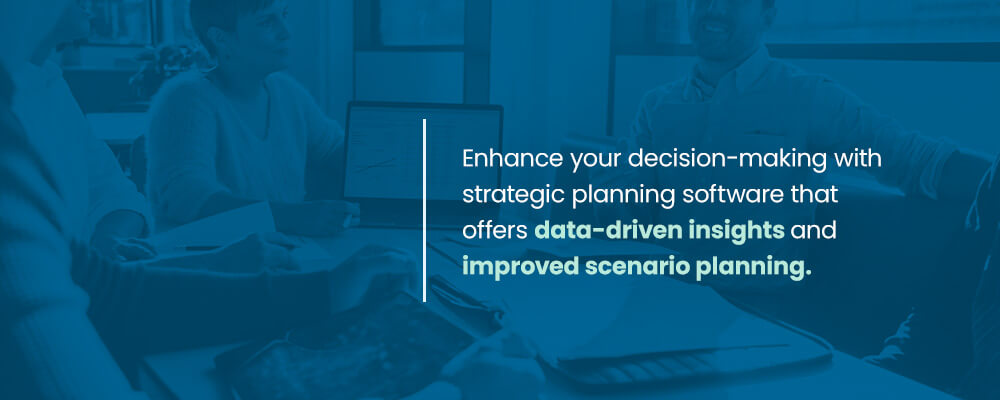
Enhance your decision-making with strategic planning software that offers data-driven insights and improved scenario planning. Real-time data analytics and reporting capabilities deliver accurate, timely information, enabling your top executives to make informed decisions.
Your organization can use strategic planning software to model different scenarios and outcomes, helping leaders evaluate potential opportunities and risks before finalizing decisions.
More informed decision-making can support improved resource allocation, project success rates, stakeholder alignment and adaptability, giving your organization a competitive advantage.
3. Enhanced Operational Efficiency
Strategic planning software boosts efficiency with streamlined processes, such as automated financial data consolidation or reporting, to support time-saving.
Automated data collection, performance tracking and reporting reduce manual effort and human errors, resulting in less downtime and more efficient operations. With strategic planning software, teams can spend less time on manual reporting and disparate tools. This gives them more time to focus on reaching company goals.
4. Better Resource Allocation
Strategic planning software provides tools for improved financial management, analysis, planning and allocation, helping you optimize spending based on importance and your main initiatives. You can allocate resources more effectively with the help of strategic planning software that supports optimized spending.
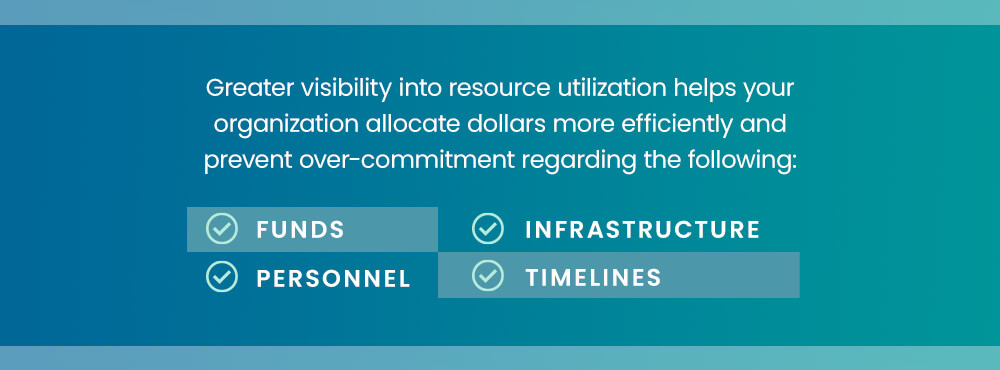
Greater visibility into resource utilization helps your organization allocate dollars more efficiently and prevent over-commitment regarding the following:
- Funds
- Personnel
- Infrastructure
- Timelines
5. Enhanced Performance Tracking
Strategic planning software enhances performance tracking with real-time monitoring and tools to enhance accountability.
Advanced monitoring capabilities enable you to track key performance indicators (KPIs) in real time, providing insights you can use to reach your strategic goals faster.
With a centralized platform, you can view individual and departmental performance clearly, boosting accountability and encouraging teams to stay on schedule with their strategic objectives.
6. Greater Agility and Adaptability

Your company can become more agile with strategic planning software, responding to change swiftly and effectively.
When you have a centralized platform to communicate across departments efficiently and make informed decisions, the organization can more easily adapt to change with greater success.
Real-time data enables you to collect, analyze and share insights rapidly, giving your teams the information they need to adapt to evolving environments and revise your strategies in ways that align with your goals.
Ongoing performance monitoring and feedback loops make it easier to continuously refine your strategies, improve operations and achieve better results.
7. Enhanced Collaboration and Communication
Strategic planning software with a centralized platform makes communicating, collaborating and executing plans easier across different teams and individuals. Each department plays a different role, and it’s vital for each division to work together for successful corporate strategy implementation.
Strategic planning software gives departments the tools and platform they need to:
- Communicate effectively.
- Share updates and performance metrics.
- Ensure everyone works in alignment toward common goals.
Having a centralized dashboard also makes remote collaboration easier for individuals and departments. Software with mobile integration can help teams stay informed on the go.
8. Risk Management
Scenario analysis tools included in strategic planning software help your company develop contingency plans and prepare for unexpected challenges.
You can use the software to identify potential risks associated with strategic initiatives, such as market volatility, regulatory changes or supply chain issues, and adjust your plans as necessary.
9. Improved Employee Engagement

You can boost employee morale and engagement when you implement strategic planning software in your organization.
A centralized platform increases employee awareness of how their work contributes to the organization’s strategic goals, increasing motivation. It also gives leaders the ability to measure and recognize individual contributions to strategic objectives, fostering a culture of accountability and appreciation.
10. Long-Term Sustainability
Planning software enables you to maintain a long-term focus on your objectives to sustain growth and competitiveness. The insights you gain from the software can help you make better investment decisions and focus more time and resources on initiatives that drive the most value.
11. Greater Environmental, Social and Governance (ESG) Performance
Strategic planning software’s insights can also help you improve your ESG performance. With this resource, you can track specific KPIs related to your impact on the environment and society. This helps align your strategies with stakeholder expectations and sustainability practices to improve your brand reputation.
Common Pain Points for Departmental Roles and How Strategic Planning Software Provides Solutions
Different stakeholders and departments within your organization may face unique hurdles, and strategic planning can provide solutions.
Consider how this resource can help you solve the following types of challenges to enhance alignment, efficiency and growth:
1. Executive Management
Executives may struggle to align goals with overall corporate strategies, which can result in fragmented efforts and undesirable results. They may also face decision-making delays because tracking KPIs and metrics across various divisions can be cumbersome. This makes it hard to track performance and assess organizational health accurately.
Strategic planning software aggregates each department’s data into a centralized dashboard. This provides executives with real-time visibility of performance metrics and alignment with long-term goals. Each executive can create and track strategic objectives across departments, ensuring accountability and alignment. They can also use automated reporting features to reduce manual data collection and analysis, enabling faster decision-making.
Using strategic planning software to manage departments helps drive your organization toward common goals, enhances operational efficiency and boosts profitability.
2. Finance Department
Finance departments often face challenges such as inefficient budgeting, forecasting difficulties and complex data management. Traditional budgeting processes are often time-consuming and lack agility, resulting in inefficient resource allocation.
Attempting to predict financial outcomes and manage complex data from multiple sources can overwhelm finance professionals and cause them to misallocate resources or experience resource constraints.
Real-time budget tracking helps finance departments track expenditures against budgets, enabling them to make timely adjustments and allocate resources efficiently. Your finance team can seamlessly integrate strategy planning software with your organization’s existing financial systems for a holistic view of monetary performance, making managing and analyzing data easier.
Finance departments can also use scenario planning tools to model various scenarios and visualize potential outcomes based on varying strategic initiatives, which enables them to make more informed budgeting decisions. With strategic planning software, your organization’s finance teams can optimize resource usage, reduce overhead costs and enhance financial stability.
3. Human Resources
Human resources (HR) departments typically face challenges with task alignment, performance measurement and employee engagement. Misalignment between company objectives and workforce capabilities can hinder organizational effectiveness.
If your HR department cannot measure employee performance against strategic goals effectively, employee accountability and development may plummet. Without acknowledgment of their contributions, employees may not see how their roles contribute to the company and gradually lose motivation or lower their engagement in their work. This can also cause employees to be more resistant to change within the company.
Strategic planning software integrates organizational goals with HR metrics, providing HR professionals with insights into employee capabilities and how they align with your company’s strategic initiatives. Performance management tools can help your HR department set, measure and track employee performance against goals to identify gaps and development opportunities.

HR professionals can also take advantage of employee engagement surveys to assess employee sentiments and willingness toward change. By choosing and motivating the right talent, your HR department can enhance workforce retention and effectiveness to facilitate sustained growth.
4. Marketing Department
Without strategic planning software, marketing departments often struggle to measure the return on investment (ROI) of campaigns against strategic goals. This can hinder budget justification and lead to ineffective strategy adjustments.
Marketing professionals can also face challenges regarding dynamic market conditions and data silos. These teams must quickly adapt their strategies to keep up with rapidly changing customer demands, which is challenging without the right tools. When marketing data resides in different systems, silos can impair comprehensive analysis and make it even harder for teams to update their advertising strategies and reach your target audience effectively.
Campaign performance tracking allows marketing departments to set measurable KPIs, track ROI and adjust strategies for each campaign in real time. Integrated market analysis tools help teams respond quickly to changes in consumer dynamics, helping them maintain relevant, effective strategies.
Your marketing team can use a centralized data repository to manage this data, eliminate silos and gather comprehensive insights for better decision-making.
Enhancing marketing effectiveness with strategy planning software improves customer acquisition and retention, which can result in higher revenue and market share.
5. Sales Department

Aligned sales and marketing efforts can enhance customer experiences and increase profits. Similar to marketing, sales departments often face challenges regarding misalignment, performance tracking and market adaptability.
Tracking performance, keeping up with market changes and aligning sales targets with company objectives is difficult without the right tools, but strategy planning software can help.
With strategy planning software, sales teams can set clear targets and link them to strategic goals, ensuring focus and alignment. Advanced analytic tools enable sales leaders to monitor sales performance against objectives using real-time data. This makes adjusting sales strategies in a timely manner and keeping up with market changes simpler for your team.
Integrating strategy planning software with your customer relationship management (CRM) system provides you with a comprehensive view of customer interactions and sales performance. This ultimately leads to improved customer relationships and increased revenue generation.
6. IT Department
IT departments are vital for keeping your company’s technology aligned with its goals. If your IT personnel struggle to measure each tool’s impact on organizational goals, they may end up using it ineffectively, investing in the wrong solutions or wasting valuable tech.
A strategic planning software solution’s project prioritization tools help IT teams focus on projects based on how well they align with company objectives.
Impact assessment metrics enable IT professionals to measure and track the impact of important initiatives on organizational goals, demonstrating value and gaining support for future projects.
Tools for tracking IT resources and workload help ensure projects have the appropriate staffing and stay on schedule. Optimizing IT investments leverages technology to drive innovation and efficiency, helping your organization grow.
7. Operations
Operations departments often experience inefficiencies when processes and strategic objectives are misaligned. Without clear performance metric visibility and effective team collaboration, they struggle to identify areas for improvement and end up executing processes inconsistently. This ultimately leads to low service quality and wasted time and resources.
With strategic planning software, operations can map processes, pinpoint inefficiencies, and drive continuous improvement. These solutions also feature performance dashboards for real-time visibility into your key operational metrics, which enables teams to monitor performance and make more informed decisions.
Streamlining your operations with strategic planning software is an excellent way to reduce costs, improve services, enhance customer satisfaction and increase revenue generation.
8. Strategy Leaders
Communication gaps often hinder strategy leaders from sharing visions and initiatives across various levels within the organization. They may also face resistance from employees when trying to implement new strategies, especially if teams are accustomed to existing processes.
As market conditions change at a rapid pace, these leaders might struggle to adapt their strategies in a timely manner. Measuring a plan’s performance and effectiveness makes evaluating what works and what needs adjustment more challenging.
The centralized communication platform within strategic planning software makes it easier for leaders to share initiatives, inform teams and engage employees.
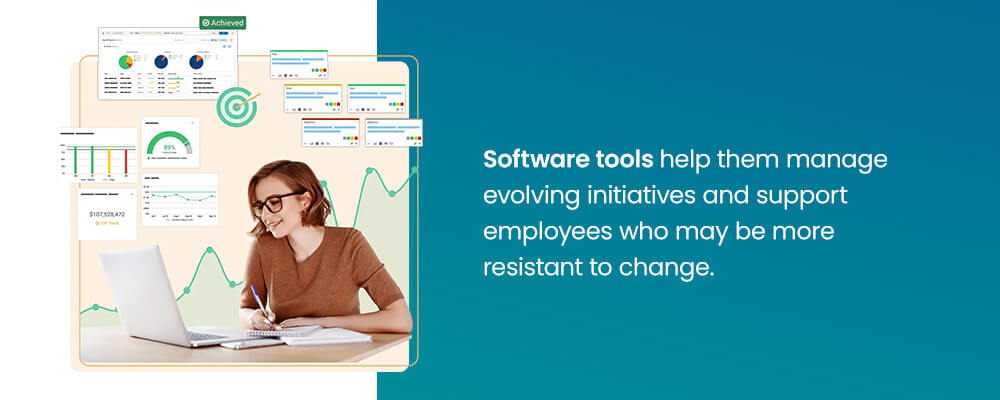
Software tools help them manage evolving initiatives and support employees who may be more resistant to change. They can use built-in feedback tools and real-time data to assess employee understanding and adjust communication when necessary. With a clear framework for strategic execution, leaders can ensure that employees across the organization are aligned and focused on objectives.
9. Board Members
Board members may lack real-time visibility into an organization’s performance and progress without strategic planning software. This limited insight can make it difficult to align short-term actions with long-term goals and assess potential risks regarding strategic initiatives.
Without access to relevant, comprehensive data, the ability of board members to provide valuable guidance is impaired. Strategic planning software provides comprehensive reporting features, risk management dashboards and alignment tracking so board members can quickly and accurately monitor strategic coherence. This capability enables them to provide valuable oversight and ensure strategic initiatives align with the company’s long-term goals and risk tolerance.
10. Investors
Investors need assurance that your organization has a clear and viable plan to reach its objectives. If they lack confidence in your strategic direction and ability to reach goals, they will be less likely to invest.
In order to convince investors of your company’s value and success, you must help them understand their roles and unique impact on financial performance, how you position your company in the market compared to competitors and how your strategic initiatives help you reach short and long-term goals. Investors expect clear communication and honest reporting, and transparency issues can raise red flags for them.
Strategic planning software helps you provide transparent reports on all initiatives, financial forecasts and performance metrics to increase stakeholder confidence. Investors can monitor real-time key metrics on centralized dashboards, enabling them to assess your organization’s health and financial growth potential with ease.
Increasing transparency with strategic planning software instills confidence in investors, fostering long-term partnerships that are mutually beneficial.
How Does the Investment in Strategic Planning Software Impact an Organization’s Bottom Line?
Strategic planning software can significantly enhance your company’s bottom line. Higher employee productivity and engagement, improved resource allocation, real-time data insights and greater investor confidence help reduce overhead costs while bringing in more revenue. When you achieve alignment with corporate goals, you can boost profits and take your business to new levels.
What Key Factors Should Your Organization Take Into Account When Investing in Strategic Planning Software?
When investing in strategic planning software, it’s important to choose a solution that meets your company’s needs. Consider the following factors in your decision to ensure your selected software aligns with your goals and can maximize your ROI:
1. Alignment with Organizational Goals and Specific Needs
Choosing strategic planning software that aligns with your company’s goals is essential. First, define your goals, long-term objectives and departmental needs. Here are some examples of what your company might focus on depending on your main objectives and areas for improvement:
- Increased revenue
- The development of specific innovations for tranforming the future of your industry
- Global growth
- Personalized employee performance tracking with unique recognition systems
- Enhanced sales and marketing methods
- Increased customer acquisition and retention
- Greater sustainability
- Improved departmental alignment
- Enhanced communication and transparency
- Stronger investor support
- Improved efficiency and reduced costs for a higher ROI
Once you define your goals, look for strategic planning software with the tools you need to reach those objectives. For example, personalized performance plans can help you create unique recognition systems and boost motivation, and customizable task management tools can help teams collaborate efficiently.
Pay close attention to the software features available and how they work to determine how well they can support your initiatives.
2. Scalability
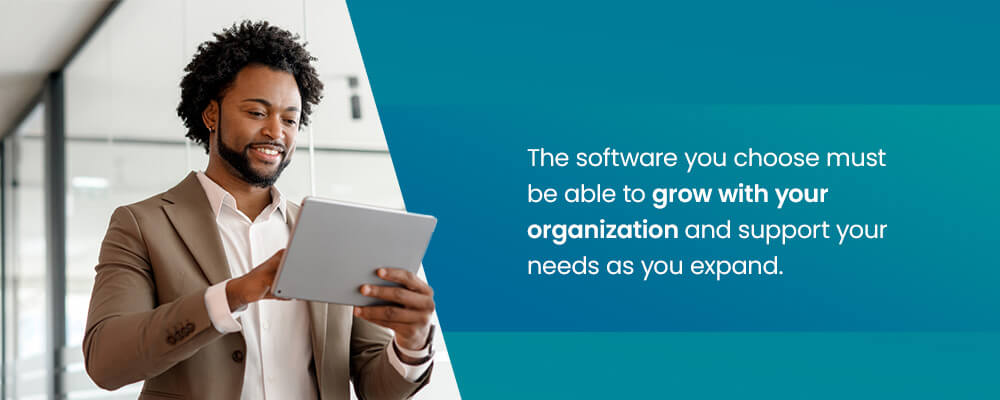
The software you choose must be able to grow with your organization and support your needs as you expand. Consider how scalable the software is before deciding on it. How many users can it support? Does it offer expanded features, and can it integrate with new systems? Think about your company’s potential future needs regarding staffing, key metrics, reporting, workflows, technology and marketing.
3. User Experience and Adoption
The easier a software solution’s dashboards and controls are to use, the more effectively your departments can implement it. Evaluate the software’s user interface and user experience before choosing an option to invest in.
Intuitive, customizable designs make implementing software features and integrating them into your processes simpler. This can ultimately lead to higher employee engagement adoption rates, resulting in successful implementation and greater growth potential.
Another important part of the user experience is training and support. Choose a software vendor that offers effective onboarding training and ongoing support to maximize the software’s capabilities.
4. Integration Capabilities
Evaluate how compatible a strategic planning software solution is with your existing systems and technology. Smooth integration is vital for effective communication, data analysis, progress tracking and user experience.
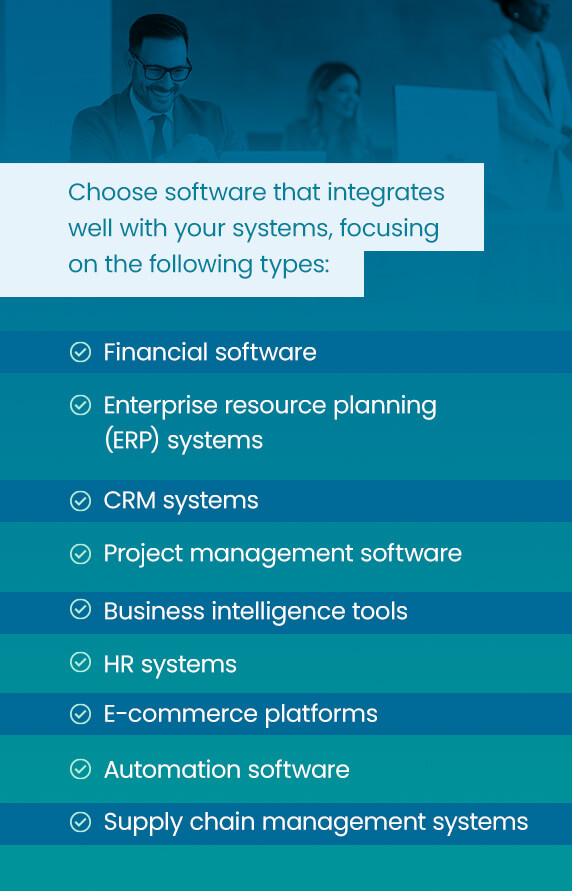
Choose software that integrates well with your systems, focusing on the following types:
- Financial software
- Enterprise resource planning (ERP) systems
- CRM systems
- Project management software
- Business intelligence tools
- HR systems
- E-commerce platforms
- Automation software
- Supply chain management systems
Smooth strategy planning software integration minimizes process disruptions and enhances data flow across your organization’s departments. Look for a vendor that offers robust application programming interfaces (APIs) for optimized customization and integration.
5. Cost-Benefit Analysis
Estimate your potential strategic planning software ROI based on projected cost savings, efficiency gains and revenue increases. Consider your total cost of ownership, including the initial purchase and ongoing costs such as training, support, maintenance and updates.
6. Vendor Reputation and Reliability
Consider a software vendor’s reputation to ensure you choose a reliable, supportive provider. Research its industry history, including its customer base, years of experience and case studies. Third-party reviews and testimonials also provide valuable insights into a vendor’s capabilities and dependability. Use these resources to gauge user satisfaction and evaluate how well a software provider can meet your needs.
7. Security and Compliance
Following data security standards is crucial for protecting your organization’s data and the personal information of your customers. Meeting regulatory compliance helps you avoid penalties, fines, reputational damage and criminal charges.
Before choosing a software vendor, ensure it adheres to the data security standards relevant to your company. For example, you may need to meet the following regulations based on your industry, location and the locations of the clients or customers you serve:
- General Data Protection Regulation (GDPR): GDPR is a law that protects European Union (EU) citizens’ personal data. If your organization processes data of EU or European Economic Area (EEA) citizens, you must comply with GDPR regulations.
- Health Insurance Portability and Accountability Act (HIPAA): HIPAA sets U.S. national standards for protecting sensitive health information.
- Payment Card Industry Data Security Standard (PCI DSS): PCI DSS standards ensure secure credit card information handling to protect cardholder data.
- The Sarbanes-Oxley (SOX) Act: The SOX Act is a U.S. law that protects investors from fraudulent accounting practices. If your company is publicly traded or plans to go public, you must adhere to the SOX Act.
8. Performance Metrics and Reporting
Consider what type of information is most valuable to your organization and ensure your strategic planning software’s reporting capabilities align with your needs.
The software you choose should provide insights that are meaningful to your industry, processes and goals so you can make the most informed decisions possible.
Software with customizable metrics is one of the best options because it enables you to optimize KPIs in alignment with your strategic goals.
9. Collaboration Features
Selecting a software solution that facilitates cross-departmental collaboration is vital for effective communication and consistency across your organization.
The best solutions offer real-time feedback tools, which improve communication, collaboration, employee engagement and responsiveness to strategic adjustments.
10. Implementation Timeline and Process
A software vendor’s implementation process can impact your operations and outcomes. Consider how a vendor manages the following elements of implementation:
- Key milestones
- Timelines
- Required resources
- Potential user resistance and challenges
11. Future Trends and Innovations
As technology rapidly advances, it’s important to choose software that can grow and adapt with future changes. Machine learning and artificial intelligence (AI) are the latest technological trends in strategic planning software, enabling you to access data-driven insights and predictive analytics. These capabilities significantly enhance efficiency and decision-making so your company can reach goals effectively.
Before choosing strategic planning software, ensure it features AI capabilities, can work with AI-powered programs or will implement advanced capabilities in the future.
How to Successfully Implement Strategic Planning Software in Your Organization
How you use strategic planning software is just as essential as the vendor you choose, and the right implementation process helps ensure strategic alignment. You can successfully implement this invaluable tool in your systems and processes with the following tips:
Develop a Clear Implementation Plan
Before implementing strategic planning software, learn about your vendor’s implementation process and the role your teams and departments will play in it. Create a detailed plan, including an initial start date and each individual’s specific roles and responsibilities in ensuring a smooth software implementation.
Your plan should also include details on which programs you will need to update or integrate with the new software.
Set Timelines and Milestones
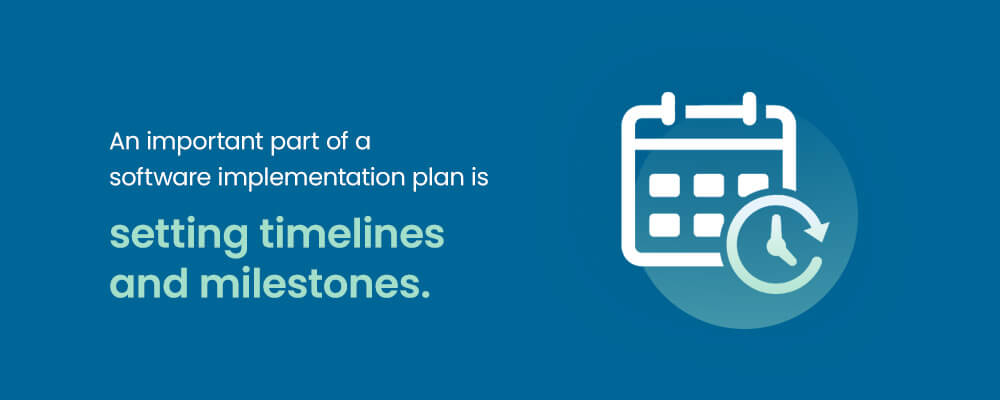
An important part of a software implementation plan is setting timelines and milestones. Determine when you will complete important implementation milestones such as training employees, launching the software and tracking results.
To evaluate the success of your software implementation, establish specific, measurable, achievable and time-bound (SMART) goals. For example, a SMART goal might be to reduce project timelines by 15% or improve reporting accuracy by 20% within the first quarter of implementing the software.
Educate Each Department on How to Use the Software
The more your employees understand the new strategic planning software, the more successfully they can implement it into their processes. Include the following elements in your onboarding and training initiatives for the greatest outcomes:
- The software’s value for the company: Help teams and departments understand the value of strategic planning software and how it will benefit the company. You can present predicted outcomes, examples and testimonials to help individual employees visualize the software’s advantages.
- How to use the software: Provide in-depth training sessions so employees understand how the software works and how to carry out their regular tasks with the solution’s new capabilities. Each department might use the system’s tools a little differently, so tailor your training sessions based on specific roles and needs. For example, you might train the marketing department on how to access and use CRM data and teach the HR department how to track employee performance metrics.
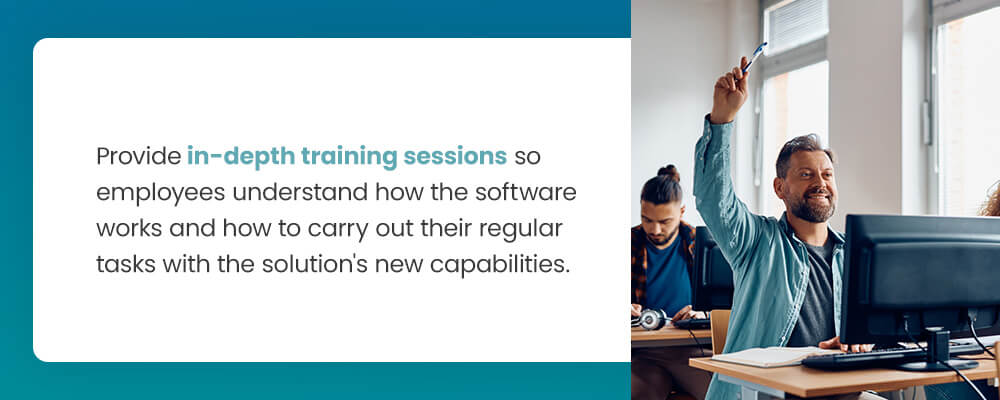
- Software features: Even if they don’t use all of the software’s features directly, it’s helpful for employees to understand what the software offers and how it may change each department’s processes.
- Troubleshooting resources: Learning how to use new software and integrate it with existing processes can be a lot to take in. Provide each employee with clear instructions and troubleshooting tips they can reference if they encounter challenges. You can also provide department leaders with the software vendor’s customer support information in case they need further assistance.
Foster a Strategic Planning Culture
Fostering a strategic planning culture can help employees get on board with your new software and objectives. Use these tips to help teams boost productivity and work toward company objectives:
- Communicate strategies during training sessions
- Educate employees on the importance of each task and objective
- Use specific metrics to measure performance and track progress
- Highlight how each employee’s efforts have moved key metrics forward during performance reviews
- Maintain specific, transparent objectives
- Align your strategies with the company’s vision and mission
- Allow employees to voice opinions and vote on appropriate company decisions
- Display key insights and progress metrics where employees can view them frequently
Establish New Communication Guidelines
Strategic planning software enhances communication, but only if each department understands how to use its features to their advantage. Create clear communication guidelines to establish and maintain departmental consistency.
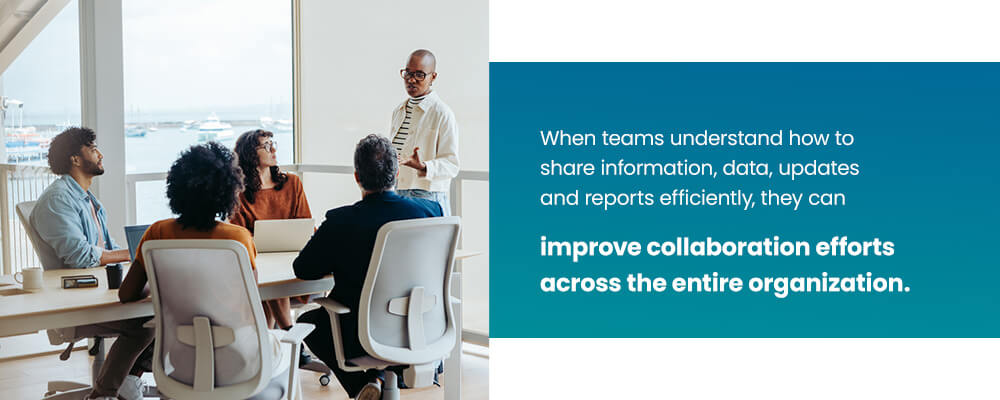
When teams understand how to share information, data, updates and reports efficiently, they can improve collaboration efforts across the entire organization.
Assign Taskowners
Clear task ownership prevents confusion, ensuring each individual understands their role in using the software, reporting updates and communicating with other departments. This helps foster accountability and a commitment toward progress.
Monitor Progress and Update Stakeholders
After your software has been in place for a set amount of time, you can begin to track progress against your goals and objectives and update stakeholders. Regularly monitor KPIs to determine how effectively departments are using the software, and provide consistent updates to investors, board members, department leaders and employees.
Let teams know when they reach important milestones, and set measurable goals for areas needing improvement.
Make Adjustments if Necessary
As you continue monitoring KPIs, you can pinpoint specific areas in your strategic plans that require adjustment. Use your new software’s centralized dashboard and reporting features to communicate adjustments with key stakeholders.
AchieveIt’s Strategic Planning Software
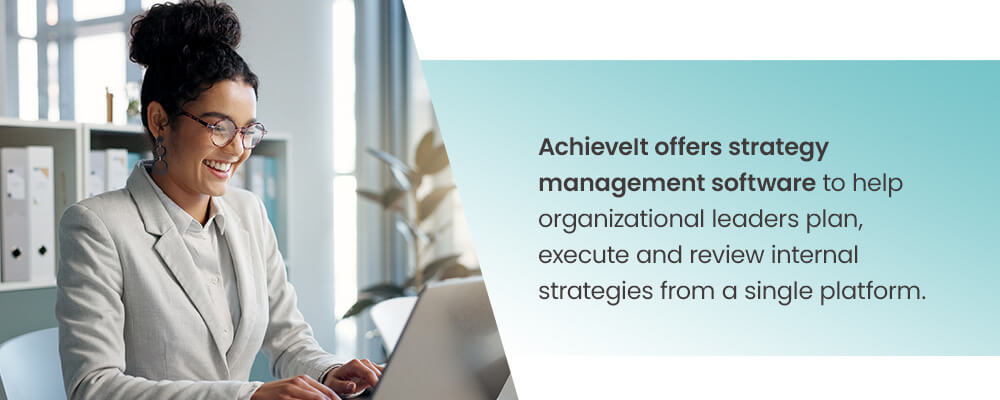
AchieveIt offers strategy management software to help organizational leaders plan, execute and review internal strategies from a single platform. Our management and execution software offers the following advantages:
Seamless Implementation
Transitioning from previous strategy management methods is seamless with AchieveIt’s initial software training. We also offer ongoing support to ensure you have assistance and updates when you need them. Management guidance and on-site roll-outs make it easy to prepare your teams for new processes.
Automation of Data Collection
AchieveIt sends automatic progress updates, ensuring the most up-to-date data and reducing human error. You can set the automated requests at your preferred frequency and cadence to meet your specific needs.
Enhanced Visibility
AchieveIt’s customizable, unified dashboard enhances visibility across your entire organization. With AchieveIt, you can access everything you need in one place, accessing plans and initiatives with ease.
Streamlined Accountability
You can streamline your meetings and enhance accountability with AchieveIt’s concise reports, emails and data. You can replace long, unproductive meetings with quick dashboard visits to streamline decision-making and increase each team’s efficiency.
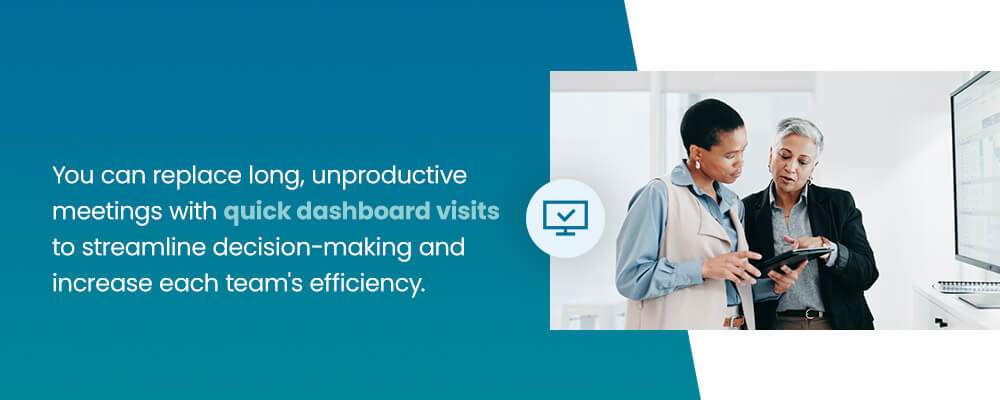
Fast and Effective Strategic Execution
When you use AchieveIt to enhance your strategy planning, you can execute plans faster and improve results. Greater organizational alignment increases the chances of successful strategy implementation and increased profits.
Drive Results With AchieveIt’s Strategic Planning Software
Strategic planning software is vital if you want to align strategies with company goals, track progress, reduce costs, execute plans effectively and improve your bottom line. As your company grows and expands, it’s important to invest in tools that help you streamline systems and operations. From real-time collection to centralized dashboards, strategic planning software makes it easier to assess your company’s current state, identify areas for improvement, and keep all departments aligned.
AchieveIt offers strategic planning software to help you optimize leadership, resources and communication. Even the most well-crafted vision requires the right tools for proper execution and alignment with key objectives, and AchieveIt offers the comprehensive platform you need. Request a demo to learn more about AchieveIt’s strategic planning software.



